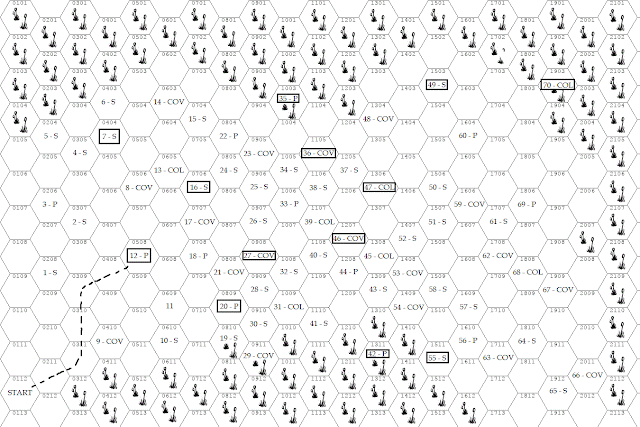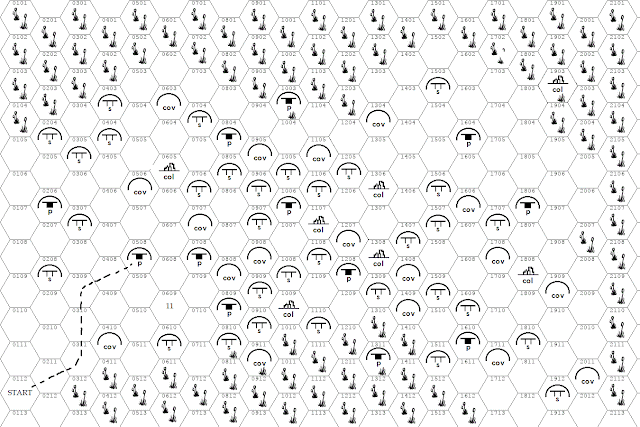I recently encountered barrow mound #16 from Barrowmaze,
titled “The Sword-Mound of the Ancients.” In this sealed tomb, six skeletal
warriors stand in alcoves surrounding an altar. A bejeweled magic longsword
lies there and, predictably, attack anyone who
tries to take the sword. This is pretty much all the detail Barrowmaze provides about the tomb.
And
I get it. Having short, concise descriptions can be a good thing. However,
there are also times when I think the paucity of text hinders Barrowmaze. I
think this tomb is one of those times. As an RPG player who looks for fantasy
and narrative engagements, this tomb temptingly raises several
questions that have no answer, such as:
·
Who are the skeletal warriors around this
sword?
·
Why are the skeletal warriors protecting this
sword?
·
What’s special about this sword?
·
Why did the barrow’s creators entomb this
sword, rather than use it themselves?
Furthermore, the tomb itself feels logically
inconsistent. Those who buried the sword here obviously intended to keep people
from using it, as they sealed the tomb and surrounded the sword with six
skeletons that attack anyone who tries to take it.
However, despite their intention, the trap the tomb’s
designers made is woefully easy to spot. What could anyone expect to
happen, if you see a tantalizing enchanted sword lying on an altar surrounded
by six skeletons in a necromantic dungeon? What’s to keep a tomb robber from
“yoink-ing” the sword and quickly running from the tomb before the skeletons can
shake the dust off their bones? What’s to keep tomb robbers from murdering the
helpless skeletons before they animate, crushing their skulls or whatever?
To be clear, I’m not against letting the party circumvent
challenges with clever solutions. But the trap here feels uninspired, and the
solutions to it feel “too easy” and unearned. The party can simply get a Generic
Sword of +1 Banality “for free” by grabbing it and running away. That solution
hardly seems clever, just obvious.
So, I took it upon myself to “flesh out” this scenario a
bit. This comes at the expense of adding more words to its description, but I
think it “pays off” in terms of depth, and originality.
PART 1: THE STORY OF BARROW MOUND #16
Gann was a simple farmer until he witnessed a giant eat
his wife and infant son whole. In a rage, Gann threw a spear through the
giant’s eye and, when the giant knelt in pain, slit its neck. From the giant’s
bones, Gann carved the baneful sword Splinter and set upon a rampage against
the giants, eventually killing their chief Senach and halting their incursions
against the humans (for a while).
Gann eventually died. His surviving shield-mates, none of
whom possessed Gann’s strength and wisdom, carved a tomb for him and laid his
sword there - as none of them were able to use it. For a while, pilgrims ventured to his burial site and attempted to
lift his sword, but none succeeded. With time, his remaining shield-mates died
and were interred there. The barrow-builders sealed his tomb with the
sword inside.
PART 2: THE GREATSWORD OF BONE, KNOWN AS “SPLINTER”
Splinter is a two-handed greatsword constructed of
giants’ bones. Its handle and blade are carved of a single bone. A cross-guard
fashioned from a second piece of bone fits over it. Blood from ages past stains
its tallow-colored blade. Runes decorate it and imbue it with magic.
The runes say, “Strength and wisdom bring justice to
those who prey on those smaller than themselves.” As a result, only a character
with a Strength score of 16 or higher and a Wisdom score of 13 or higher can
effectively wield Splinter. The sword feels impossibly heavy for any other
creature.
Human-sized creatures wield Splinter as a two-handed
sword. When fighting giants, Splinter has a magical +3 bonus. When fighting
other creatures, Splinter has a magical +1 bonus. When fighting
creatures smaller than oneself (ex. halflings), Splinter instead attacks the
wielder as a +3 weapon.
Splinter, being constructed of bone, weighs half as much
as a metal two-handed sword. It feels surprisingly light in its wielder’s
hands. However, it is also fragile. At the referee’s discretion (ex. when used
against metal armor or subject to a sundering attempt), Splinter begins to
fracture and may eventually break. Clerical magic can repair it (ex. the cure
light wounds or restoration spells) but not traditional smithing.
PART 3: BARROW MOUND #16 (HACKED)
“You
descend a short flight of stairs into a tomb sixty feet long and thirty feet
wide. Six upright sarcophagi line the walls, three on each side. Unlit
braziers and wall carvings decorate the space between
each. A seventh sarcophagus lies horizontally at the opposite end of the
room, atop a small flight of stairs. An altar sits in front of the
sarcophagus, a rune-covered sword lying atop it on a dusty crimson cloth.”
·
Six Upright Sarcophagi: Made
of mortared giants’ bones. Five have names carved on them, each containing the
remains of Gann’s shield-mates. Breaching the lid of any named sarcophagus causes
the all the skeletons to animate and attack the tomb-robbers. They pursue the
desecrators with supernatural persistence until either the tomb-robbers or they
themselves are defeated. Should they defeat the tomb-robbers, the skeletons
hunt giants once more with the fragments of memory they still possess. The one
sarcophagus without a name on it has an open back leading to #81.
·
Braziers: made
of hollowed-out giants’ skulls. Filled with cold coals.
·
Decorative Wall Carvings: Four
in total (one between each pair of the shield-mates’ sarcophagi)
- Depicting Gann throwing a spear through a giant’s eye with a house burning in the background
- Depicting Gann carving a bone into the shape of a sword, a light from heaven shining down on him
- Depicting Gann and his five shield-mates slaying an army of giants while wielding Splinter
- Depicting Gann boarding a ship with no sails (representing death), taking the hands of a woman and boy (his wife and son) who reside there. His sword lies behind him on an altar, surrounded by a throng of people.
·
Seventh Sarcophagus:
Made of mortared giants’ bones. The graven image on its lid depicts Gann in
repose. Opening the lid reveals Gann inside and causes Gann and his
shield-mates to animate. Two urns on either side of the sarcophagus bear the
names of his wife and son, as well as a prayer that they find peace in the
afterlife despite their physical remains being destroyed. An inscription from
Gann on each says he loves them.
·
Altar: Here Splinter lies
on a crimson cloth, surrounded by candles long unlit. A carving on the altar says, "May one as strong and wise as Gann wield this blade once more."


